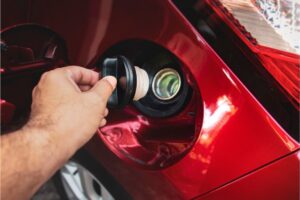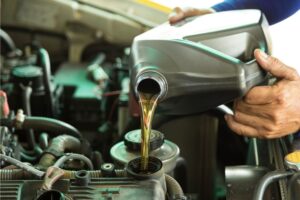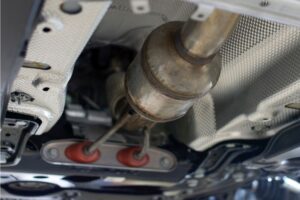As car enthusiasts or not, you may have, at some point, asked yourself the question of how badly you can damage a car, whether that’s blowing up or simply destroying a car.
Humans are curious by nature and rarely hesitate to ponder upon the weirdest questions.
Particularly interesting is a car’s gas tank that can easily get a car blown up once something flammable is slid inside, such as a cloth on fire.
Which brings us to the question, how to ruin a car engine through the gas tank?
There are several different ways you can do that; depending on how severely you want to damage the car.
But if you are keen on simply harming the car’s engine, then pouring in the following in the gas tank will surely do the necessary harm you intend.
- Bleach Can Ruin the Engine Easily
- Water – Harmful Liquid for Car’s Engine
- Carbonated Drinks for Ruining A Car’s Engine
- Salt Can Ruin the Car’s Engine
- Urine – Another Harmful Factor For Car’s Engine
- Sugar – No more fuel’s Supply To the Engine
Anything that is not gasoline will easily sabotage the engine’s integrity when tossed into the gas tank. Therefore, a car’s gas tank is among the most vulnerable components to damages.
Table of Contents
- 1 How Is It That Easy to Ruin A Car’s Engine?
- 2 What Do You Put In The Gas Tank To Ruin Your Engine?
- 3 What If Is Your Fuel Tank Filled With Something Other Than Gasoline?
- 4 Conclusion
How Is It That Easy to Ruin A Car’s Engine?

The answer to this question boils down to one of the most important components of a car, which is the fuel filter.
Like other car components, the fuel filter is necessary to secure a well-performing engine. However, not many people are aware of the fuel filter.
Maintaining it is often overlooked by the people unaware of its existence, partially because not everyone is an automobile expert.
Nonetheless, I believe that understanding this particular component of the car and how it works will only make it easier for you to know how best to ruin the car’s engine through its gas tank.
What Is A Fuel Filter?
All fuel engine cars have a fuel tank essential for your car to operate as it supplies power to the engine.
To make this easier to understand, I would like to draw a parallel between a fuel filter with a regular air filtration system.
Both have essentially the same function and purpose, which is to prevent any impurity from passing through from one plain to another.
However, there is a chance that impurities like dirt and unwanted matter exist in the fuel, which can negatively affect the performance of the car’s engine.
Due to this reason, car manufacturers invented the fuel filter that functions only to prevent the impurities in the fuel from passing through to the engine for the ultimate purpose of better engine performance.
Where Is The Fuel Filter Located?
The fuel filter is usually located in either of two locations surrounding the car’s fuel tank and the engine.
The most common location of the fuel tank is somewhere inside the fuel tank, generally near the opening of the car’s fuel line, which supplies gas to the engine.
You may find the fuel filter inside the fuel line itself, located beneath the car.
If you are unaware of where the fuel filter is in your car, then look at your car’s documentation which will surely provide the details.
Why It May Be Helpful To Understand The Fuel Filter
With all that being said, it should be a lot clearer as to why the fuel tank is one of the most sensitive targets you want to hit if you plan to cause harm to any car’s engine.
A car’s fuel filter located in the gas tank is only destined to filter out impurities from gas. Hence it will not be efficient to do the same for other substances.
As a result, the engine will be exposed to harmful matter particulates and eventually become so damaged that it ceases to function.
What Do You Put In The Gas Tank To Ruin Your Engine?
Anyone can easily compromise a car’s engine, and many people question what would be the absolute worst thing to throw in a car’s gas tank.
The answer is quite simple; anything besides fuel liquid will generally harm the car’s engine in various ways.
Liquids such as bleach, urine, cooking oil, coke, etc., are among the most harmful substances that will damage the engine or even stall a car’s engine.
So with that said, go ahead and pick the most readily available substance to you and wreck the car’s engine you want.
Never mind the various reasons you might want to do this, as long as no human being gets harmed in any way possible.
Just be responsible so that you do not destroy somebody else’s property as it is illegal and can land you straight in prison.
Like I said earlier, almost any liquid can be used to pour into the gas tank to bring harm to the engine of a car.
Some of them are as follows:
1. Bleach Can Ruin The Engine Easily
Safety precautions are especially important if you are about to work with bleach, as it can cause serious harm to your skin if it gets in contact.
But from a different perspective, using bleach to wreck a car’s engine may be one of the best ways to go about it.
The equally interesting point is that despite having a considerable volume of bleach in the tank, the car may still startup because of the fuel in the tank and even run for some distance.
However, once the fuel runs out and the only thing in the gas tank is bleach, you leave the car and its engine to become severely damaged.
So, in contrast, even if there is some fuel left in the tank, the car may not even start at all.
This is because leaving bleach in the car’s system for long periods can start the process of rust on the various components inside the car.
In addition to that, it is worth knowing why bleach is so harmful; and the simple explanation is that it is because bleach contains chlorine, an extremely corrosive oxidant.
Bleach has been proven to be the most effective for ruining any car’s engine by supplying it with this corrosive liquid through the fuel tank.
It is also one of the cheapest ways to find when ruining a car’s engine.
2. Water – Harmful Liquid For Car’s Engine
Water is yet another harmful liquid that is very efficient and quick at eroding a car’s motor.
I must add that as much as 90 percent of bleach is made up of water, and by now, you should be well aware of how damaging bleach is, so consider water just as harmful?
Since most of the composition of bleach is made up of water, pouring water into a car’s fuel tank will have almost the same effect as adding bleach with only one key difference.
It will have an extremely toxic effect on the car’s engine. Furthermore, mixing the fuel inside the car’s fuel tank with water will be no different than mixing it with bleach.
Water Is As Toxic As Other Liquids?
Although it may seem relatively harmless, having water in the car’s fuel tank is no less toxic than any other liquid mentioned in this article.
Especially if the car is still getting driven around with water in its system, it may run unsuspiciously before coming to a complete halt mid-journey.
What Is Extremely Destructive?
Water can be extremely destructive to a car’s engine if it gets in contact, even in the smallest quantities. This is why cleaning the engine is also done so cautiously.
Here are some signs to determine if there is water in the gas tank as water can be your engine’s enemy, especially if it is directly supplied to it through the fuel line.
- Engine light: The very first thing you should check before you start driving your car is to check whether the engine light is on. This is an easy way to detect anything wrong with the car’s engine.
- Misfires: Another sign of water in the fuel tank can be a misfire that is resulted from the water entering the car’s combustion chamber.
- Rough Acceleration: This term relates to how an object moves and can be used to detect whether there is water present in the fuel tank.
Bleach Vs. Water
There is one major disparity between the impact both water and bleach will have on the engine: corrosion and rust induced on the engine and its components.
Only bleach and its corrosive characteristics can deal with this type of damage to the engine. Hence, it is the most effective harmful liquid to be poured into a car.
However, that is not to take away from the damaging capabilities of water. It can lead to extremely dangerous circumstances if a person drives a car filled with water in the fuel tank.
Among the dangerous consequences can include the car becoming uncontrollable, leading to car crashes and the engine’s displacement from its mount itself.
Therefore, it is highly recommended that you ensure nobody will drive the car once you are done with your mischievous acts, as it can lead to severely dangerous outcomes.
3. Carbonated Drinks For Ruining A Car’s Engine
Among the many ways of ruining a car engine also consists of using soda drinks to pour into the car’s gas tank to cause detrimental harm to the engine.
This is because the by-product of mixing carbonated liquid with gasoline is highly corrosive goo that clogs the engine and halts its function.
What Should You Do To Reverse This?
If you regret pouring soda into your automobile’s gas tank and want to undo what you have done, it is drivable again.
Your best bet would be seeing a mechanic or taking the car to an auto repair shop. There, the expert mechanics will examine the car and develop the best solution.
It is worth noting that your engine will have dealt considerable damage, and you should be financially prepared to face the inevitable burden of getting it fixed.
4. Salt Can Ruin The Car’s Engine
Several harmful consequences result from adding salt to a car’s fuel tank.
To begin with, the fuel tank’s bottom surface will start to corrode over time as the salt accumulates in large quantities.
In addition to that, the car’s engine will eventually stop functioning as the fuel filter is completely blocked by the salt crystals formed after mixing with gasoline.
Hydrogen peroxide’s characteristics can maximize your car engine’s power level, which will result in super speeds.
When it is coupled with gasoline, you have an even stronger substance than the fuel itself, and it may be similar to a Nitrous boost used in sports cars.
To add to that, you may also notice a sudden rise in the car’s temperature, and it may become too heated that it won’t be able to start.
However, this should not be assumed to be a good thing, as the massive increase in power and speed leads to dangerously high temperatures in the engine, which may cause it to even explode if not destroyed.
5. Urine – Another Harmful Factor For Car’s Engine
How much damage can urine cause to a car’s engine if poured into the fuel tank, and is it a unique case for this topic of discussion?
Firstly, no, it is not a relatively special case with unique effects compared to other substances mentioned here.
I will explain why! Secondly, the amount of damage caused to the engine by urine depends on the volume added to the vehicle’s system.
Furthermore, urine is essentially very similar to water and maybe pass as contaminated water, so the harmful effects on a car’s engine will not be so different from those caused by pure water.
Moreover, urine contains some quantities of salt. Hence the salt may deposit at the bottom surface if the temperature is high enough, leading to a blockade at the fuel filter.
As a result, the engine will be prevented from receiving any fuel if there is any in the tank and eventually cease it from operating altogether.
In essence, urine is yet another liquid that will do nothing but harm your car’s engine regardless of whether the process takes long.
6. Sugar – No More Fuel’s Supply To The Engine
Sugar is yet another example of a substance that can be used to create a harmful impact on a car’s engine along with its nearby components.
Furthermore, if sugar is poured into a car’s gas tank, there is no doubt that the result will be a damaged car engine.
Such deterioration is because the sugar will not dissolve in the gas tank as it is not soluble in gasoline.
Once in the gas tank, it will remain in its original state and accumulate at the bottom of the surface.
In addition to that, the sugar deposits will work as a barricade that will prevent the fuel from passing through the fuel filter and supply the engine with the power necessary for the car to run.
As a result, the car will eventually come to a halt after a few kilometers of the drive.
Possible Solutions
- Change The Fuel Filter: The sugar will eventually be collected by the fuel filter, whose primary purpose is to prevent any solid matter from passing through over to the engine.
- Replace The Fuel Pump: Once some of the sugar has passed through the fuel filter, it will begin to settle in the fuel pump. Hence you will also be required to get a new one as a solution.
- Get A Mechanic: If in the case that the sugar has passed through the fuel filter and fuel pump, then the next area it will settle at will be the car’s fuel delivery system.
Therefore, you will need to bring in an expert mechanic who will completely remove the fuel tank and clean it.
What If Is Your Fuel Tank Filled With Something Other Than Gasoline?
Whatever the case issue, maybe when it comes to your automobile, the most sound, and ideal approach would be to seek a professional mechanic’s help.
Deciding to fix any problem related to something you have limited knowledge about can only cause more trouble and difficulties; hence, you need to consult with someone with the required expertise.
Conclusion
Regardless of the most damaging substance, the reality is that as long as it is not fuel, then there is a very strong possibility that the engine and its components will become subject to destruction.
In other words, you do not have to be an expert in automotive to know exactly how to ruin a car engine through the gas tank.
However, if you intend to harm someone else’s car, you must acknowledge that it is illegal, and I strongly advise AGAINST it.
Nevertheless, I merely hope that this article successfully extends your knowledge on the harmful effects of throwing in random things in the gas tank of a car, which will eventually ruin its engine.

I am Tahir Azam, and I have been writing amazing articles for TaxiHack for as long as I can remember. I know everything that is to know when it comes to automobiles and is always on top of industry news and developments. While I am not an expert by any means, I pride myself on knowing the ins and outs of many different problems and, of course, their solutions. The articles on our website are some of the best and well-researched content that you will find, and I spend countless hours making sure this remains to be true. This is why I ask you to take your time out and read some of my articles, especially if you find a topic that resonates with you or is something you are looking into. This way, you will find the perfect mix of information and tips on your desired topic. Learn more about Tahir.


